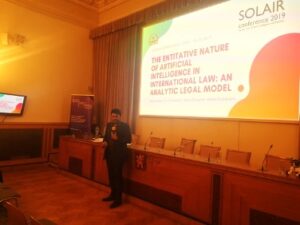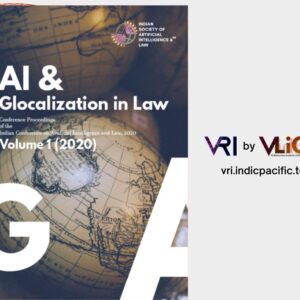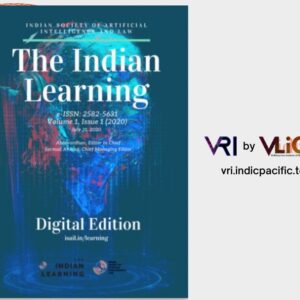This work is licensed under Creative Commons Attribution-NonCommercial-NoDerivatives 4.0 International ![]()
The idea behind international algorithmic law was new, nevertheless a lot old. In September 2019, I was invited to present a paper on the Entitative Nature of Artificial Intelligence, at the SOLAIR Conference, Prague (Praha), Czech Republic. This conference was my first international engagement, academically, and apart from this critical engagement, I had delivered my first session on artificial intelligence and law in the same month at the Bannerghata campus of NMIMS Bengaluru, where along with 2 academic experts, the Indian Society of Artificial Intelligence and Law, as an idea, had held a workshop. Both of these crucial engagements and my first book on AI Ethics and International Law (published by BPB in June-July 2019), were pivotal in inspiring me to lead the foundation of the Indian Society of Artificial Intelligence and Law, in November 2019. As the Society was formed, one of the sections of that paper presented inspired me further to work on the possible idea of international algorithmic law, in mid-2020, amidst the global pandemic.

My presentation on AI and Law at SOLAIR Conference, Prague, in September 2019
While the idea of international algorithmic law was maturing, I had discovered some traces of it long back in 2020. As someone who has specialised in public international law in his LLB studies from Lucknow, and space and telecommunications law (later on) from Hyderabad, my deep fascination for this scholarly field of law was central to the way the digital age was gaining relevance. At that time, when I had proposed that diplomatic practices under the Vienna Convention on Diplomatic Relations (a rather old international law treaty) would be affected by automation, analytics and other umbrella categories of “artificial intelligence” or “AI”, it could not be expected that a lot of theoretical inferences made – could come true. This is striking since in the times when GPTs and compute dictate possibilities of AI adoption, and product managers and influencers have gained more relevance than real AI researchers, thanks to AI hype (or say GenAI hype) in the global economy, some of the ideas have gained value.
Now, legal enforcement doesn’t matter when automation is either highly distributive and federalised (if not decentralised) across many countries. Yes, many countries have attempted to come up with legislations, rules, guidelines and even non-binding soft law frameworks (I’ve discussed in this book) to govern or regulate “AI”. However, either some of those frameworks are too stringent, or the use cases of “AI” are not considered reliable anymore, thereby impacting the possibilities of AI safety research as well. Nevertheless, countries have found ways to enable normative practices which might enable the splintering of the digital world (or maybe some redirections).
Ironically, as the incessant proliferation of AI slop data, information and content has been spread across the internet, thanks to the desperation of top AI companies in Pao Alto, Beijing and other places in the Global North, a lot of globally and publicly available ‘content’ has been extracted. However, it somehow boils down to the way social media was made, because companies like Perplexity and OpenAI have already decided to attempt breaking into Google’s search market, and dominate the SEO side of things. There are multiple reasons for this, including that traditional “FAAMG” companies or “YMANGA” companies (YCombinator, Meta, Amazon, NVIDIA, Google and Apple) have either pivoted to newer options with their fragmented tech and business divisions to improve their deliverables, or they have gone into oblivion, like say Google’s many service apps, some of the old Microsoft apps and Meta’s Facebook. This is where one has to understand that the AI story is not as done and dusted, as it seems. Enterprise AI solutions are still not implemented at a high-level, and even if they are being piloted, their implementation has not been successful, even for traditional YMANGA/FAAMG companies. This is where even India Inc. giants have been struggling.
Still, it does not answer the question: why this book? Why revisiting an idea after 5 years? Why does it make sense to cover something so theoretical in the age when despite GPT slop, many social science and law researchers across the world are losing relevance due to their ineffective and unethical research practices? Here’s a simple answer to these questions. The real advent of automation (not Generative AI), and computation advances in AI research, has proven that we will usher a decade where AI communities, both technical and multidisciplinary, will be extremely distributed, or largely federalised. For instance, many YMANGA/FAAMG companies might not be able to achieve certain AI solutions despite the resources they have, and the talent they have acquired, or poached. However, someone who is a fourth-year engineering student in India, might be working on his / her next paper to be presented at an ACM / IEEE conference next year, proving that their AI / machine learning technique has something unique to offer. It might not be as scalable as social media or messaging apps like Whatsapp, but it might offer something valuable. The value is the decelerated control of AI hype-enabled influencing over the evolution of AI/ ML as a subset of digital technologies and information systems, giving power back to an average AI researcher and innovator, from marketers and influencers. This is inevitable to happen, despite the occurrence of Jevons Paradox, as in the case of DeepSeek R1, which was released in late January 2025, since efficiency of use of compute and associated tech infrastructure does not automatically answer whether the AI tool is adaptable to anyone in workplaces, or whether it is technically sustainable in terms of its learning capabilities.
In the multidisciplinary world, government regulators in a largely multipolar world would not be able to impose regulations the way we assume (which I have discussed in this book) unless they have some risk appetite – like China for instance. In such situations, every regulatory position shall be scrutinised as if that legal / policy position is subject to some intellectual salami slicing. That cut-throat questionability of these government stances on AI governance would stem thanks to industry forums, civil society groups, technical associations, open source communities, labour unions, trade unions, lawyer associations, professional associations and even government employees’ associations. Of course, only those forums which retain value and specialisation will have any strength to speak up, and self-regulate markets, products/ services and people. However, wherever any automation or AI solution will be implemented, end-users who are the “beneficiaries” will question how exactly that automation is supposed to work, and specialists and ground-level stakeholders will have to brainstorm, paving the way for inclusive solutions. This is why hagiographies on AI and knowledge by should be ignored that all knowledge is automated, and that everything is settled. Language models weren’t perfect, and while they have some strengths in enabling simpler tasks, which includes world models and visual models, they cannot be considered a progenitor to any form of AGI or artificial general intelligence.
Hence, a complex mesh of binding and non-binding AI frameworks will float around, as if they are some fabric, whose each edge is contestable: whose existence is penetrable and questionable. Therefore – I found it grateful to write about normative emergence in cyber geographies. I am glad that my efforts have been helpful, since many of the scholarly conjectures made about this field – IAL – have been proven thanks to real-life sources (primary and secondary), and examples. I hope this book intrigues both – those who love building AI for good, and those who wish to make it inclusive and explainable plus ethical.
Abhivardhan
Managing Partner, Indic Pacific Legal Research
President, Indian Society of Artificial Intelligence and Law
| VLiGTA Resource Identifier | Norm_Geo_IAL |
|---|---|
| ISBN/ISSN | |
| Author(s) | |
| Publisher | |
| Publication Type | Digital |


![Regulatory Sovereignty in India: Indigenizing Competition-Technology Approaches [ISAIL-TR-001]](https://indopacific.app/wp-content/uploads/2023/02/uiwstqwdd-IPLR-Gmail-ADMIN-300x300.jpeg)
Already on VLiGTA? Log in
Having trouble logging in? Learner help center
This site is protected by reCAPTCHA Enterprise and the Google Privacy Policy and Terms of Service apply.